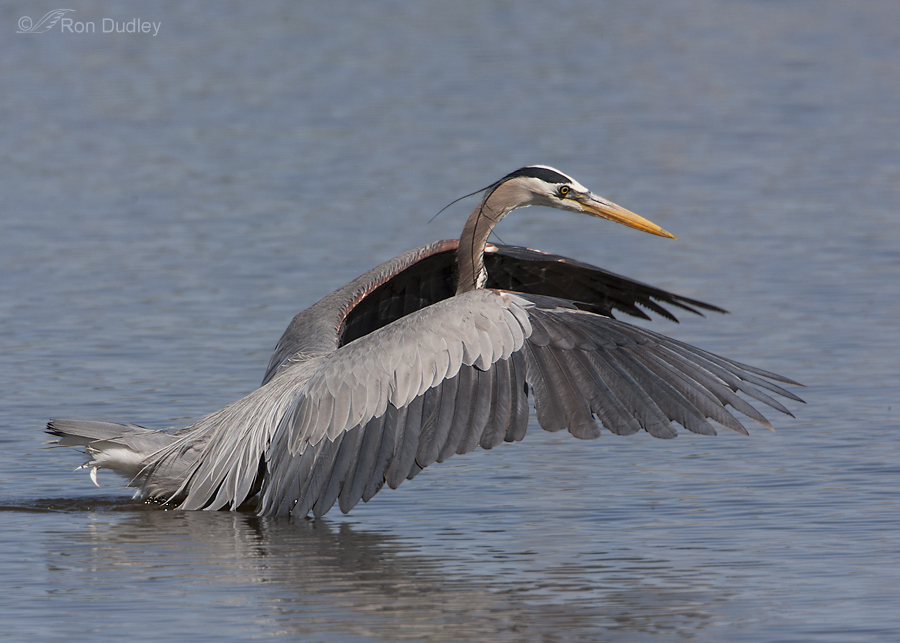I’ve spent a fair number of years now photographing Great Blue Herons and I’d never before seen this behavior from the species.
1/1600, f/8, ISO 400, 500 f/4, 1.4 tc, natural light
Apparently this bird was “canopy feeding” – bringing both wings forward to form a canopy, the shadow from which attracts fish. I know it’s a fairly common behavior in some egrets and herons but I was quite surprised to see it from a Great Blue. My research finds no mention of it with the species.
So, I’m curious enough to ask if any of my readers have seen this behavior in Great Blue Herons. I know that some of you observe them much more than I do and I’m wondering if it’s something I’ve just missed seeing by chance or if this is unusual for them. Or maybe the bird was doing something else…?
Any thoughts?
Ron



i don’t know the “why” of it but it is a great capture of the pose and feather details.
I hope you find an answer (and naturally I can be of no assistance). Just the same – thank you for another beautiful, and thought provoking post.
Ron…In looking at this canopy photo some more, I have a couple of additional thoughts. First, after checking out some of my GBH hunting photos, this one is different in another way. What I see in mine is the head tilted much more downward, almost looking straight down at the ‘target’. Your photo shows a GBH seeming to look much more forward.
Also, I’ve seen a lot of wing demonstrations — both in the water and out of it — during courtship rituals. The Blue Herons don’t exactly dance, like the Sandhills, but they do have elaborate rituals. Any chance at all that this could be what you photographed?
I suppose it’s possible, Terry. This image was taken on May 6 so ritualized behavior isn’t out of the question.
But this bird was in the middle of a fairly large pond and I didn’t see any other herons nearby.
I too had noticed that the bird wasn’t looking directly down but I believe it was still looking into the water, just further ahead.
Thank you for your additional input.
I watch and photograph GBHs a lot down in Corpus Christi, and enjoy them for their “posing” and stalking behavior. I, too, have never seen one do this, and also wonder if it is not an anomalous learned behavior.
Could be, Lane. I just don’t know for sure.
Cool! I never go intentionally bird watching, so the only way I see them here is in flight.
Thanks, Chris.
I’ve been photographing Great Blues since 2009. I’ve never seen any of them do this when ‘dining.’ My question would be whether you actually saw any head diving for food from this posture. We all know that photographs can be misleading, as that frozen second in time when an exposure made can capture a ‘pose’ which is only an instant in some other activity.
Terry, it’s been a while since this photo was taken and I can’t remember if the bird actually exhibited “head diving” but I do remember thinking that there was no question that it was in hunting mode.
I’ve never seen this before, but now I’ll be on the lookout for it!
Thanks for the great posts.
I keep looking for the behavior again too, Bruce but have yet to see it again.
We have a lot of Great Blues out here (Clements ,Ca), but it’s pasture and vernal pools. They seem to enjoy hanging out by the cattle as I have observe them next to the herd on many occasions. Behavior may depend on the prey of course, but I have never seen them on a lake or pond feeding.
Thanks for the info on your experience with them, 48dodger.
I have had the same experience as you have and have not noticed this with great blues but in some of the other species, most notable the tri colored herons and rusty egrets, This is an amazing shot!
Charlotte
Glad you like it, Charlotte.
Great Blue Herons are one bird we certainly get plenty of here in Orange County NY, and I have never seen this behavior before. I am wondering if maybe it is a learned behavior?
Could be, Matthew. I just don’t know…